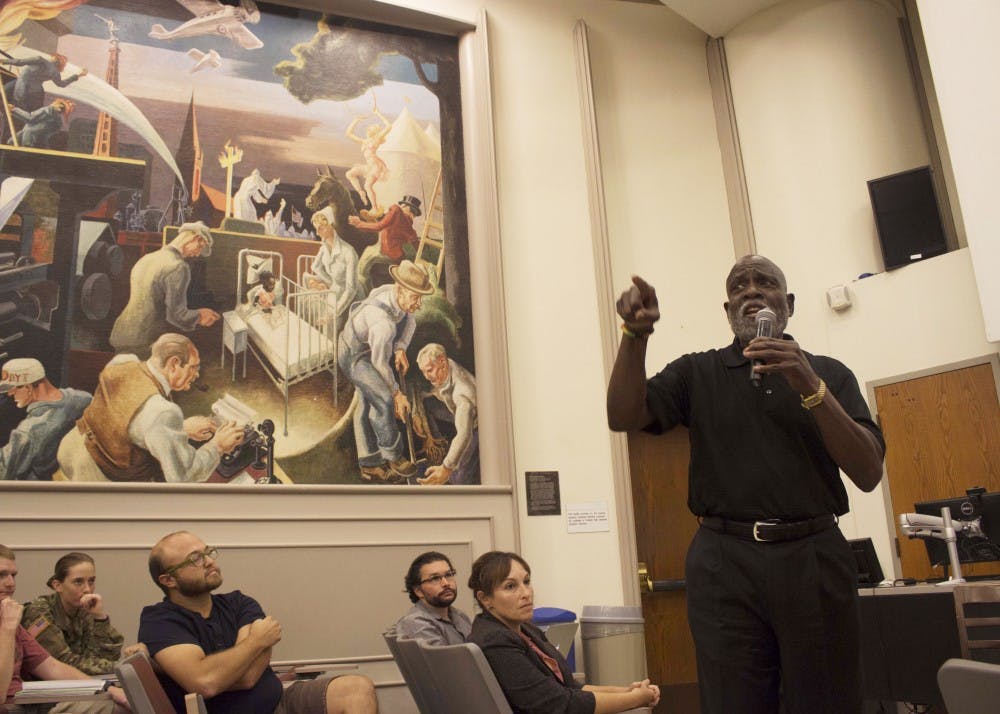In 2002, a committee decided to keep the Benton Murals, one of which depicts members of the Ku Klux Klan, in Woodburn Hall 100, and faculty were supposed to show a video to their classes explaining the history of the mural at the beginning of the semester.
That practice died out within a few years, and any context for the piece was limited to two posters behind glass that are now displayed outside the classroom. These explainers have not provided enough meaning to stand against recent calls for IU to remove the mural.
Because of this, students, faculty and community members found themselves in heated arguments Thursday evening as they sat in Woodburn 100 during a panel sponsored by Political and Civic Engagement discussing what IU should do with the murals.
Charlie Nelms, a black former IU vice president who was on the committee back in 2002, sat in the audience. He was the first to talk after the panelists’ opening statements and walked to the front of the room to try to explain his reasons for keeping the mural.
“I took the position then, and I take the position now, to keep the mural because the Klan is part of the history of Indiana, and we dare not cover that up,” Nelms said. “We need to use that as an opportunity to talk about the issues of today.”
Nelms said he was frustrated because most of the people who were talking had only ever read or heard stories about the Klan, but he had firsthand experiences with the group growing up.
“The Klan used to meet in the woods down the road from my house,” Nelms said. “I drank from the colored water fountain. So don’t tell me about the Klan. I know all about the Klan’s business.”
After the former administrator spoke, panelist and black law professor Kevin Brown said he had lost respect for Nelms.
Brown said in his opening statement that he thought that without a question the mural should be taken down.
“That is a very hurtful thing for many black students,” Brown said.
Nelms came back to the front to defend his opinion.
“We don’t all have to agree on everything,” Nelms said. “My position is you don’t paint out the history and pretend that everything is so pristine.”
Nelms said the murals should all be put back together it their original intended form.
Nan Brewer, a curator at the IU Eskenazi Museum of Art and expert on the Benton Murals, brought a diagram to show people how the murals were originally displayed at the “Century of Progress” exposition at the 1933 Chicago World’s Fair.
At that time, the murals encompassed an entire room. The position of the murals was an important part of the artwork depicting people’s perspectives. Cultural and industrial history were parallel to each other.
The piece of the mural depicting the KKK was a back corner piece. This panel of the mural is called “The Parks, the Circus, the Klan, the Press.” The panel is anti-KKK, Brewer said.
Brewer pointed out several key points of the mural. The church behind the KKK was St. Charles Catholic, chosen because Catholics were another group targeted by the KKK. Beside the KKK is a circus made up of Catholic immigrants.
Below the KKK are a pair of journalists representing the role they played in the KKK's fall from power in Indiana. The journalists were facing not toward the Klan rally, but at a black child in a hospital bed being cared for by a white nurse, Brewer said.
Even after learning about the murals’ history, some students still argued against their presence.
Panelist Ashley Scurlock said she remembered the murals from campus orientation.
The junior sat in Woodburn 100 with few other students of color while the orientation leader claimed the University worked hard to uphold a culture of diversity. She was promised that there was a place for everyone on campus while the whole time looking up at an image of a burning cross and the Ku Klux Klan.
“The Benton Mural as a whole was mentioned and praised,” Scurlock said. “But the KKK depiction was ignored. Yes, it made me feel uncomfortable. It made me feel unwelcome, like the entire speech I was listening to was untrue.”
A black female student said she was annoyed that the mural is in a room where students are required to attend class.
“I don’t want to look up at the KKK during my organic chemistry class,” she said, and the audience applauded.
A white senior and member of the army ROTC program said she was tired of hearing only the white panel members advocate leaving the mural up and in its original location.
“I’m white, but it bothers me,” she said. “It’s a problem. We’re talking about the difficulty of moving this piece of artwork, and I understand that art is important. At what expense are we not going to move it? Is the damage to the mural more important than the damage that’s happening to students as they sit in this room? It’s not worth it. Take the freaking thing out of here.”
This story has been updated to reflect PACE's sponsorship of the event.






